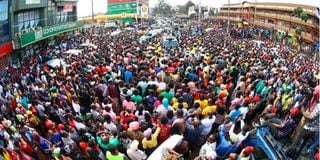Premium
Democracy land: Campaigning in the the ‘opposition’ heartland

Part of a crowd that attended Deputy President William Ruto’s rally in Kiganjo, Gatundu South Constituency, on March 19, 2022.
What you need to know:
- At Ichaweri, Ruto met with landowners who have petitioned the court against compulsory relocation from their property.
- The DP’s delegation that descended on Gatundu in a cascade of car convoys were political envoys and “bad boys”.
When Deputy President William Samoei Ruto went to campaign against President Kenyatta in South Gatundu at the end of last week, he was in effect daring to step where no angel has dared tread before — not even Kenya’s first Vice President, Jaramogi Oginga Odinga, who went toe-to-toe with his boss, Jomo Kenyatta, resulting in the famous “there cannot be two bulls in one kraal” warning.
At Mutomo shopping centre, the Deputy President even had the temerity to mention the mother of the President by name, as he recalled how she and the clergy had prayed for them “to overcome the cases we (they) faced at the ICC in The Hague” .
And the knob on the audacity dial was turned up a notch higher when, at Ichaweri, the ancestral home of founding President Mzee Jomo Kenyatta, the Deputy President met with landowners who have petitioned the court against compulsory relocation from their property (to pave way for the expansion of Mama Ngina University).
“No one will have their ancestral land grabbed,” he reassured them. “The country is led by the constitution, so if you have title deeds, do not panic.”
Ichaweri is where President Jomo Kenyatta used to receive delegations (at his Gatundu home), like one from Western Province recorded in the archives of the Voice of Kenya in 1973 that was led by “the chairman of the Kenya National Chamber of Commerce, Mr Elijah A. Anane, P.C. P.K.
Boit and Assistant Minister for Home Affairs, Martin Shikuku, asking about water supply in Western Province, and who were addressed by His Excellency after entertainment (at his Gatundu residence) by traditional dancers and a choir”.
Last week, however, the DP’s delegation that descended on Gatundu in a cascade of car convoys were political envoys and “bad boys” like area MP Moses Kuria, and the only chorus was one of condemnation for the president’s choice to campaign for Azimio la Umoja Movement flag-bearer Raila Odinga (who was in the United Kingdom on an official political talk tour).
“Tell him (President Kenyatta) to stay out of the race so that I can defeat Raila Odinga,” Dr Ruto implored Kiambu residents in the Kiamwangi locale, taking the battle to Uhuru’s doorstep.
If the President, opening a massive medical facility (Mama Margaret Kenyatta Children’s Hospital) in Kariobangi, Nairobi, felt that the barbarians were battering the gates of his native Gatundu 40 kilometres away, then there was an unlikely mirror precedent to this, but in reverse.
In October 1969, his father as President had gone to open “Russia” hospital in Kisumu, a town then seething with rage at the July murder of Cabinet Minister Tom Mboya many believed was orchestrated by the government.
In a now infamous incident, a crowd chanting “Dume! Dume!”, the slogan of the outlawed Kenya Peoples’ Union party angrily charged the motorcade of the President.
Jomo’s bodyguards repulsed the mob with live rounds, resulting in several deaths.
According to lawyer Bobby Mkangi (and a member of the Committee of Experts behind the drafting of the 2010 constitution), this political development of being able to campaign in hitherto forbidden strongholds of one’s opposition, including the heartland of the presidency, is a yardstick of how far our democracy has come.
Some 30 years ago, in August 1992, a few months to the December elections, retired President Mwai Kibaki, who was Vice President at the time and leader of the Democratic Party, found himself facing very different grounds from the freedom that the DP Ruto enjoyed on Friday.
As Kibaki visited Lamu, Nandi, Makueni, Kiambu, Tana River, Uasin Gishu and even his native Nyeri, he encountered constant hostility and harassment from Kanu activists, the Provincial Administration and the police, all still doing the bidding of President Moi’s administration.
'Road warriors'
In Kisii town, on the orders of then Kanu supremo Simeon Nyachae (who ten years later, alongside Uhuru, would be his presidential seat rivals), Kibaki was shocked when three Mercedes Benz cars from his motorcade were impounded for alleged “unpaid hotel bills,” resulting in an angry stand-off between his security men and Kisii police.
In Gatundu last week, where part of the road had been blocked before DP Ruto arrived, with some residents bearing placards written “Respect our President!”, it was actually the police who helped clear both barricades and protesters, hand-in-hand with the DP’s handlers.
And in that September of 1992, when former Mr Kibaki ventured into the Kanu heartlands, 100 Kanu youth-wingers armed with bows, arrows and machetes stopped him from crossing Moi’s Bridge.
On the Sunday of September 13th, the most serious incident occurred, when after Mr Kibaki stopped to greet local residents, a mob of “road warriors” attacked his motorcade, a hail of rocks smashing windscreens as they overturned one of the cars in the convoy and set it alight.
John Keen, then secretary-general of the Democratic Party, condemned the incident as “an attack of state desperation that will not stop the DP leader from launching his (political) offensive in so-called Kanu zones.”
Mr Kibaki angrily mumbled that this “zoning off”of areas and restricting regions one could campaign in was “primitive paranoia by the leadership,” who had “adopted the tactics of Stone Age men”.
It is in this light that lawyer Mkangi welcomes this tolerance, right up to President Kenyatta who “respects the freedom of movement, expression and association.”





